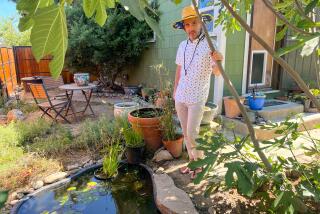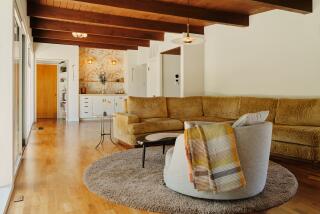Some Tips for Those Who Want to Light Up Lives and Yards
- Share via
Ever since ancient homeowners grunted through their first rough barbecues under the flickering glow of torches, we have sought to light the night’s shadows for our enjoyment, safety and security.
Today, advances in low-voltage lighting technology and a trend toward more stay-at-home lifestyles have lead to a boom in residential landscape and architectural lighting.
Manufacturers have responded to the growing consumer demand by introducing dozens of quality lighting fixtures. Where once the plastic store-bought lighting kit and tiki torch reigned supreme, a custom and increasingly stylish home market has emerged.
“There’s been a tremendous upsurge in what’s available for the residential market,” agrees Doug McIntyre, owner of Lightscapes, a Yorba Linda-based landscape-lighting firm. “Most people are unaware of the large number of fixtures and styles that are available. It can be a real eye-opener.”
It can also be a wallet-opener at about $150 per installed fixture. According to McIntyre, however, expense is relative.
“For customers who have put the big bucks into a dream home, the thing to do is to light it, to show it off,” he says. “They may not turn (the system) on every night, but if they’re entertaining guests, it can make a nice showcase.”
The 33-year-old former Disneyland theatrical-lighting expert founded his company three years ago to cater to a rapidly expanding home market. It was a need, he says, whose time had come.
“In the past, an electrician might hook up a basic system of floodlights and path lights, but it wasn’t usually done with a lot of (fixture) selection or design creativity,” he explains. “I wanted to be among the first to bring a real sense of theatrical effect to residential landscape lighting.”
Low voltage is the dynamo which is driving the surge in home installations. After years of languishing in the bargain basement of residential landscape lighting, low voltage has come into high demand.
Part of this is due to new lamp technology which has produced low-watt bulbs that burn up to four times brighter at 12 volts than they would at standard house current of 120 volts, according to McIntyre.
In addition, these low-voltage systems are usually easier and less expensive to install, and there is no danger of frying the gardener should he accidently cut an electrical line while digging up your posies.
Low voltage is also movable. Although connected to standard house current, a transformer steps down the power to the 12-volt level, eliminating the need to run wires through a rigid conduit. The wires can be cabled directly just a few inches below ground. Should tree roots, for example, later threaten a line, it can be easily pulled up, moved several feet, and reburied without a full-scale excavation of your back yard.
Judy Ziccardy, manager of Modern Electric Fixture Co., a retail lighting store in El Toro that carries a wide selection of outdoor fixtures, cites the energy-saving potential of the low-voltage systems.
“They use less electricity to accomplish the same task (as the high-voltage systems),” she says. “And the bulbs will last longer because they’re not pulling as much wattage.”
Some customers who want to light their homes but are concerned with conserving energy as a way to help save the environment are beginning to look upon low-voltage systems as a way to have their environmental cake and eat it, too, according to Ziccardy.
“They’re trying to do their part to be environmentally responsible, and they don’t feel so guilty about installing outdoor lighting using energy-saving fixtures,” she explains.
Sometimes a stumble in the dark over a garden hose or a nighttime encounter with a prowler can serve as strong incentives for a homeowner to install landscape lighting. Where there is light, there are, obviously, less accidents and less opportunity for concealment--and the intrusion of unwanted visitors.
Concerns about safety and security, however, are not the primary motivation behind the urge to illuminate, McIntyre suggests.
“For most of my customers, beautification is first in their minds,” he says. “They want pretty lights that serve an aesthetic ideal. They don’t want big, ugly security floodlights or a lot of highly visible path lighting everywhere. As the designer, they expect me to blend beauty with security and safety when I light their homes.”
McIntyre says he spends a fair amount of time and effort educating his customers about the design possibilities of outdoor lighting.
“People tend to focus just on path lighting and spot lights,” he says. “They usually don’t know about other design techniques such as moonlighting, silhouetting or cross-lighting.”
There are, in fact, at least a dozen high-design effects that can be achieved using the large variety of lighting fixtures available today. McIntyre and other suppliers work with customers to try to create a lighting plan which will best fit their wants and needs. Waterfalls, ponds, large trees, interesting architectural details and garden textures all require special lighting treatment.
McIntyre says there are two good rules of thumb to remember when designing outdoor lighting--light only what is important, and do not overlight.
Dana Butler, owner of a speciality lighting store called Light Adventure in Newport Beach, agrees with the design philosophy of keeping a low lighting profile.
“We focus on lighting without letting the viewer see the lights,” says the former Olympic swimmer (“I came in fifth in the 100-meter butterfly in 1972”) turned designer.
Butler and her associates usually try to blend lighting fixtures into the landscape, hiding them wherever possible to create “a mood that is appealing so that you’re drawn into the home.”
She claims such mood building is not possible with a blitz of bright lights overwhelming the vista they were meant to enhance.
“I guess you could say we try to be a little more artsy in our approach to lighting,” she says.
McIntyre is also taking a more “artsy” approach to his work.
Drawing on his years of experience in theatrical lighting, he has begun to incorporate special effects into his residential repertoire. An example is the recent back-yard lighting job where he used a series of projection fixtures to simulate moonlight shining through tree branches.
“It’s a theater lighting trick,” he admits. “We had a wonderful pool and waterfall we wanted to showcase, but we didn’t want to just shine some big spotlights on them. So we projected a broken moonlight pattern and let it dapple across the rocks and water. It’s very subtle, but quite effective.”
Subtlety is the rule for good outdoor lighting, McIntyre believes.
“We try to show off what’s there rather than try to draw attention to what we’ve done. In other words, if there’s a beautiful tree, I don’t want you seeing light fixtures around it--I want you to see the tree looking beautiful in the night.”
For this same reason, McIntyre and other landscape lighting designers have moved away from the use of colored lights--a trend that seems to be shared by homeowners in general.
“I can only remember one customer (who) really wanted to use color,” says McIntyre. “Most customers don’t want to go too far. Obviously, the use of color can be gaudy and overdone.”
McIntyre has no quarrel with the occasional colored light creeping onto the landscape vista. “A red light in a spa can be fun with the bubbles and all.” But he warns that use of the wrong colors, especially vivid colors, on already colorful objects such as plants can turn even the most lovely and robust flora into sickly looking ghosts of their real selves.
Like nearly everything else on the planet, landscape lighting needs continuing maintenance to stay in good working order. Burned-out bulbs need replacing, fixtures knocked about by wind and lawn mowers need adjusting, and timers should be inspected and reset.
“If you’re going to invest $5,000 in lighting, then it would behoove you to spend $45 (for a service call) once or twice a year to keep your investment up,” he says.
Although low-voltage lighting systems are available from larger lighting-fixture supply stores and are relatively simple to install, McIntyre warns that it is easy for the do-it-yourselfer to make mistakes in design and execution. After all, one homeowner’s accent light may be his neighbor’s pet peeve.
“You have to be careful of those living near you,” he says. “Shining your landscaping lights into your neighbor’s house and yard is definitely a design no-no.”
More to Read
Inside the business of entertainment
The Wide Shot brings you news, analysis and insights on everything from streaming wars to production — and what it all means for the future.
You may occasionally receive promotional content from the Los Angeles Times.










